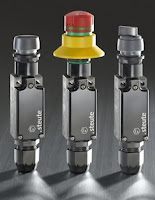A voltage spike is a momentary extreme burst of electricity in an electrical circuit. This energy spike may be short-lived, but could still be strong enough to seriously damage the electronics. Voltage spikes cause corresponding spikes in the current impulse.
There are many potential sources of power surges. Two of the most common are spikes from lightning and switching surges:
- Lightning: Lightning creates substantial electric discharge at the location it strikes. Lightning that directly strikes a building can clearly endanger its electrical system, but there are other ways for lightning strikes to cause a power surge. For example, when lightning strikes a power transmission line, the effects can cause an equally dangerous voltage spike miles away. Even in locations with infrequent lightning strikes, lightning poses a significant risk and its consequences must be mitigated.
- Switching Surge: There are many malfunctions in electrical equipment that can lead to power surges. Tripped circuit breakers, short circuits, or even power transitions can all create switching surges. These electrical irregularities may be man-made but can cause just as much damage as lightning. A large power substation that regularly cycles on and off generates enough switching surges to threaten sensitive electronic devices.
Gaps in Existing Power Surge Protection.
Industrial automation operators generally understand that power surges pose a serious threat to their systems and take steps to reduce this threat. Not only do power surges damage and destroy equipment, they cause costly interruptions. In the case of serial-to-Ethernet communications, irreplaceable historical data could be lost if the serial or Ethernet ports suffer a power surge.
For a serial device server, there are three major points of weakness that could be damaged by a power surge: the serial line, the Ethernet line, and the power line. Many serial device servers offer surge protection on the Ethernet and power lines to protect against this threat. However, most serial device servers leave the serial line unprotected. As a consequence, the serial line is often the vulnerable chink in a serial device server’s surge protection armor.
Surge Vulnerability in Substations.
Substation automation facilities are at particular risk for power surges because they are highly susceptible to both major sources of voltage spikes. As outdoor facilities, substations are more exposed to lightning strikes. As electric facilities that perform electric transformation and switching, switching surges are also a danger. At the same time, electric substations need reliable serial communications in order to perform essential tasks such as reading power meters. If surge damage occurs on a serial line, then any meter data on the associated line will be lost. This combination of increased risk profile and greater consequences means that robust products with industry-certified surge protection are a must for electric substations.
Full Spectrum Surge Protection.
Surge protection is not an option for vulnerable communications links. Effective and comprehensive surge protection reduces downtime and increases system stability by eliminating the most common cause of failure. IEC 61000-4-5 testing is imperative to verify that a device has sufficient surge protection to withstand voltage spikes. IEC 61000-4-5 Level 1 testing is intended for a device that operates in partly protected electrical environments, while IEC 61000-4-5 Level 2 and higher testing certifies that a device can operate in highly electrical environments.
Many manufacturers offer serial device servers with IEC 61000-4-5 rated surge protection on the power and Ethernet lines. However, the same level of integrated surge protection is rare for the serial line. In order to acquire serial line surge protection, device servers are often deployed with additional external surge protection devices. However, this retrofit adds complexity, increases space requirements, imposes additional maintenance costs, and complicates support cases. Industrial automation systems can be complicated enough as it is without an additional requirement to deploy, maintain, and support yet another device just to provide serial line surge protection. Closing the Gaps in Surge Protection.
Moxa NPort A Series of serial device servers sets itself apart from other solutions with built-in IEC 61000-4-5 rated surge protection on the serial line in addition to Ethernet and power line surge protection. This provides a reliable, resilient serial device server solution in a convenient all-in-one package. With built-in serial line protection, it is no longer necessary to find, test, and deploy an external serial surge protection product. Surge immunity on the serial, Ethernet, and power lines grants the compact, IEC 61000-4-5 certified Nport A series reliability and full-spectrum protection against voltage spikes and electrical noise. Moxa NPort A Series devices (pictured above right) are 1 to 4 port serial to Ethernet device servers for hazardous locations. They have enhanced surge protection for serial, LAN, and power, and 2 KV isolation for serial signals. They also have rugged screw-type terminal blocks for power and serial connectors, and are C1D2 and ATEX certified for harsh industrial environments.
@Moxa_Europe @OConnellPR #PAuto #OT/IT #PowerSurge






























